
Herding basics - Millie herding - Herding aptitude test - Herding working test - Herding competition
Herding is a tradition of hundreds of years. Many people pick it from generations, or instantly feel it, others might need to go a severe learning curve. Of course practice makes the master but if we are well prepared in theory there is a higher probability that our herding work will be more successful.
When herding, a living person herds living stock with a living dog so the number of risk factors is quite high, the result of herding cannot always be predicted, we need to be able to control the situation. The most important components of herding are: the area, sheep, dog (and of course the owner/shepherd). We will go through the most important basic commands. We can check our dog's instincts with the Herding Instinct Exam (HIE), or test our knowledge as a team at different challenges: I will list the different herding competition regulations in line with the herding styles. I only give a short summary here, those who are more interested can check the Sources. Should you have any questions, please do not hesitate to contact me.
Control - Herding area - Sheep - Dog - Herding basic commands - Herding Instinct Exam and Test - Sources

Our first
herding (at Tordas (Hungary), with Racka sheep, Millie was 11 months
old)
The most important factor is the controllability of the dog, even with high instinct situation. It is advisable to follow the below grades at training shepherd dogs as well:
-
Therapy: the dog gets to know the environment, has no frustrations, is not afraid of the sheep, the pen, the area, the shepherd etc.
-
Instinct development: in this case, developing the herding instincts. It happens, and this is the ideal, where we need no development at all since the dog has inherited excellent herding instincts. However in some cases we'd need two or five occasions to get the dog 'started'.
-
Control: to control the dog, we only let him/her approach the sheep on command, i.e. first the dog has to sit or lie down, or we define the directions (left or right) etc. A good method is to use a circular pen and have the dog herd from outside so the dog has no chance to make them run away in all directions.
-
Control in extreme circumstances: in case of herding, the dog is consciously manipulating the sheep following the shepherd's instructions in an open area.
Top
We can create an area useable for herding based on the dog's 'knowledge' level, in different sizes and 'degrees' of difficulty:
-
First, we should work with sheep in a circular pen where the dog runs around them from outside. This can be an area covered with beton/asphalt (can be used in any season but might be harmful for the dog's and sheep's legs), or a grassy area (to avoid the mud, use mobile pens and move them from time to time).
-
Herd free sheep in a fenced area.
-
The next level is a quite large, fenced, horizontal area.
-
Most difficult is to use a large area with different angles, objects, corners, places which are difficult to reach.
The good mobile pen is:
-
galvanised after production (otherwise it will be rusty and fall apart)
-
created of identical elements which can be put into each other
-
grid drawing is horizontal (if it's vertical, the sheep can be stuck, when it's horizontal, the dog cannot push the sheep so hard to stop it from moving forward)
-
buy 50% more than calculated (to keep sheep to change, or create little roads etc.)
-
circular (then the dog cannot push the sheep into the corner): to create it, push a picket in the middle, get a rope of about 10 m (or according to the size of the area), and measure equal lengths in all directions, put 6-8 marking pickets then place the mobile pen elements around them.
Top
When herding, we use the flock instinct of the sheep and herding instinct based on prey instinct of the dog. We can herd sheep kept by ourselves or others at a farm. It is useful to know the different sheep breeds and their characteristics to find the ideal sheep for our dog - especially in the beginner phase.
The ideal sheep for herding is/has:
-
Light, easy movement (would start moving at small indications from the dog. Unfortunately the heavy, massive sheep are unlikely to move)
-
Likes to flock together (there are sheeps i.e. the highland sheeps which tend to run in all directions when they are afraid)
-
Is not agressive with the dog, would not steal the dog's self confidence (this is extremely important in case of young, beginner dogs). It is advisable to avoid the aries (male sheep) because they tend to turn back on dog and people alike, and to avoid the ewe (mother sheep) with cossets (little lambs).
-
Light structured, is easy to lift or turn on the back (to check the hooves for example).
-
Best sheep are the female sheep born in the previous year which are not involved in breeding yet.
-
It is advisable to have a few 'dogged' sheep which are tending to go toward the man from the dog, but when the flock is 'automated' it is time to change some. The little lambs do not know the rules, and the lambs which are too close to people, can be touched etc. would go to the shepherd in all cases (and not to the flock) so they are to be avoided, too.
-
Best is to start herding with a slower breed i.e. merino then have a quicker breed like the (Scottish) Highland (Black faced) sheep or Hungarian Racka, etc.
-
But of course if you have no sheep like the above, just use what you can have...!
Probably you already have the dog at your feet but if you wish to select a good herding dog, it is advisable to choose one from herding ancestors, and get the most lively pup. Of course the traditional herding breeds will probably be more useable to herd but in many cases we can see other breeds showing a beautiful herding work (like poodles, scottish terriers, labrador retrievers and mixed breeds).
Characteristics of a good herding dog:
-
fitness
-
endurance
-
working instinct
-
Show the sheep to the dog at about 9-12 months
-
Then the dog should be quick enough to reach the sheep, and should be stoppable, but if the dog passes the sheep, then is not ready yet to move forward.
-
Then follow the 4-step control process above (therapy, instinct development, control and control in extreme circumstances).
How to instruct the dog:
-
using body language, silently,
-
with verbal orders, words
-
mouth whistle signes (no additional object is needed but cannot be heard from longer distance in the wind)
-
whistle device (need an extra object but can be heard from long distance in windy weather conditions).
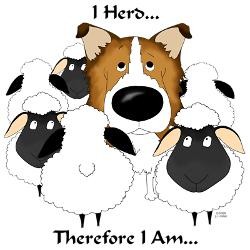
"I herd... therefore I am" - after Descartes
(you
remember: Je pense donc je suis / I think therefore I am) (source:
cafepress.com)
Basics:
Herding style: how the dog is directing the sheep where the man/shepherd requires. Most typical styles:
-
Driving method: when the dog herds the sheep away from the shepherd, so the dog and the shepherd goes after the sheep (i.e. puli).
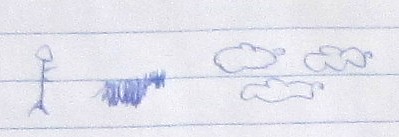
Driving
-
Fetching (collecting) method: the dog herds the sheep toward the shepherd, so the order is shepherd - sheep - dog (i.e. collie).

Fetching
(collecting)
Note: the good dog can both drive and fetch... and this is needed in evereyday practice.
Another point is the contact or lack of contact between the dog and the sheep:
-
working from distance, without physical contact (pl. eye usage of the border collie ), or
-
little bites to the sheep's legs in case of other breeds.
Balance:
The dog is placed to herd the sheep towards the shepherd. The objective is that the dog should not separate the shepherd from the sheep (at beginners level). Later the dog would need to drive the sheep away from the shepherd (then we call the dog to heel and walk slowly after the sheep, a little left-right to keep them in the direction).
We can say the sheep is like a cake: half of it is the dog's, and the other half is the shepherd's, so we don't let the dog come into our half.
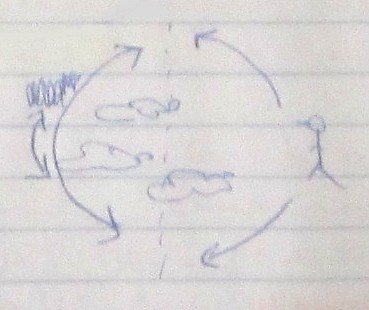
Question/excercise: in the below situation, where is the balance point, so where should the dog go to start the sheep towards the shepherd? (please note that the head of the sheep faces not the shepherd but around 90 degrees away - and the sheep go where the nose points...)
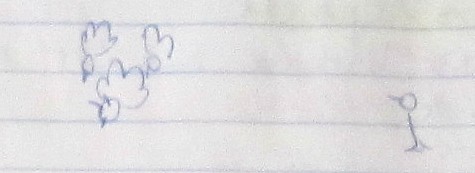
Where
is the balance point?
First idea: the dog should stand on the other end of the sheep, in line with the shepherd. Problem: the sheep would not walk toward the shepherd.

This is
not good
Solution: the dog should find the spot so that the sheep starts moving toward the shepherd, so a little 'in angle'.
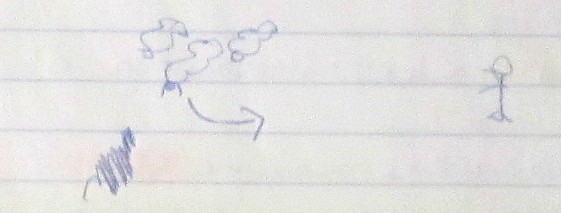
This is
good
Outrun: the dog runs around the sheep in a nice circle, goes behind the flock from a distance, to start the sheep moving toward the shepherd.

Outrun
If the shepherd moves towards the dog a little, we can make a larger nicer circle.
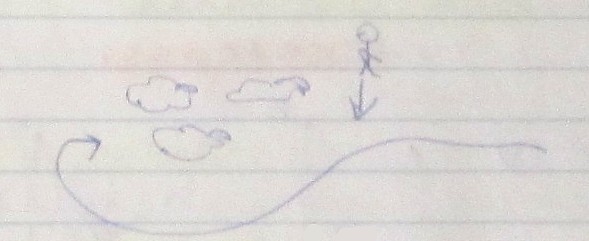
Enlarge
the outrun circle with moving toward the dog
One sheep ran away: objective is to send the dog to the other side of the single sheep so that noone is between the flock and the single sheep - no dog, no shepherd.
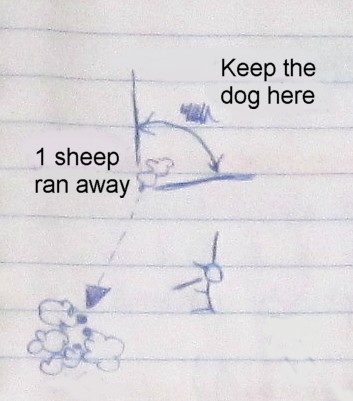
One sheep
ran away
Herding out from pen, corral, separating sheep from the pen (advised to practice without dog first):
If we move towards the sheep, they will be stuck in the corner
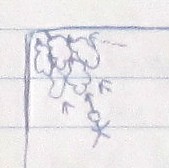
This
is not good
So we need to approach from the pen's walls, in a greater angle, and slide between the sheep and the pen. Later on we should practice this way with the dog.

This
is good, they will go outside
Changing sheep:
When herding or practicing, the most important objective is the wellness of the animals. The tired sheep should be changed to relaxed ones. If we have two pens to practice (sheep in little pen, dog running in the corridor between the large pen and the small pen), it is advisable to change sheep following the below steps:
1. Open large pen (legend: A: relaxed sheep, B: tired sheep)
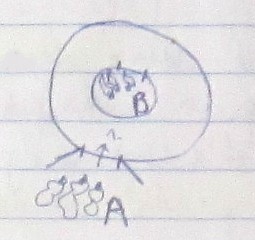
2. Herd relaxed sheep inside the large pen, outside of the small pen, to the other side in front of the open gate.
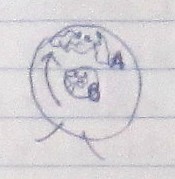
3. Open small pen fully thus blocking the relaxed sheep, herd out the tired sheep
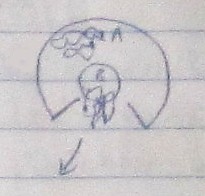
4. Close the large pen gate, herd relaxed sheep into the small pen
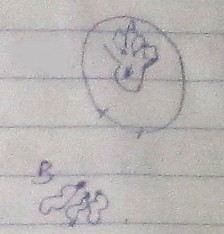
Most frequent herding commands:
-
Away (way-way-way, away from me) – Anticlockwise - left (so-so-do, so-so-do like in music solmisation so two deeper, longer signs and one higher-pitched short sign or you can just come up with your own system using your mouth or a whistle)
-
Come bye – Clockwise - right) (so-so-so-so-so like in music solmisation, so five short signs)
-
Get back / Get out - go farther away from the sheep, leave more room
-
In here - get between the sheep and separate them
-
Lie Down – literally lie down on stand (so-sooo like in musing solmisation, so one short and one long sign)
-
Look back – leave the sheep you are herding, turn back and look for more sheep
-
Stand / Stand still - stop (can be lie down, sit, stay, just slow down or stop moving)
-
Steady – slowly
-
Take time - wait, slow down
-
That'll do - it's enough for today, heel
-
There - stop moving around the sheep and go towards them directly
-
![]() Millie
video: herding alone, with music (Youtube 00:53)
Millie
video: herding alone, with music (Youtube 00:53)
Herding Instince Exam HIE and Herding Working Test HWT
Herding Instinct Exam HIE provides feedback on how much ancient instinct your dog has inherited. Here the controllability is also very important. At working test and trials, different excercises must be performed, most frequent ones are penning in and out, outrun, grazing.
More info are available on the herding exam on my Herding Working Test HWT page.
Detailed
regulations can be read and downloaded from the FCI
herding dogs regulations site.
-
FCI Herding Working Test Traditional Style regulations
-
FCI International Rules for Sheepdog Trials Traditional Style regulations
-
FCI Regulations for awarding the CACITR at International Herding Trials
-
MEOE HIE Herding Instinct Exam
-
Hungarian National Herding Competition regulation
Top
-
József Árkosi and Barbara Kiss HTC Herding Training Center Vasad, Hungary
-
László Romhányi Romhányi Ranch Rákóczifalva, Hungary
-
Ildikó Szabó Koczkáné Dél-Alföldi Terelõcentrum (South Plain Herding Center), Hódmezõvásárhely, Hungary
-
Andy Nickless Working Sheepdog, Worcester (UK)
-
Evelin Balássy Blessed Borders
-
Magyar Juh- és Kecsketenyészto Szövetség (Hungarian Sheep and Goat Breeding Association)
© www.millie.hu













